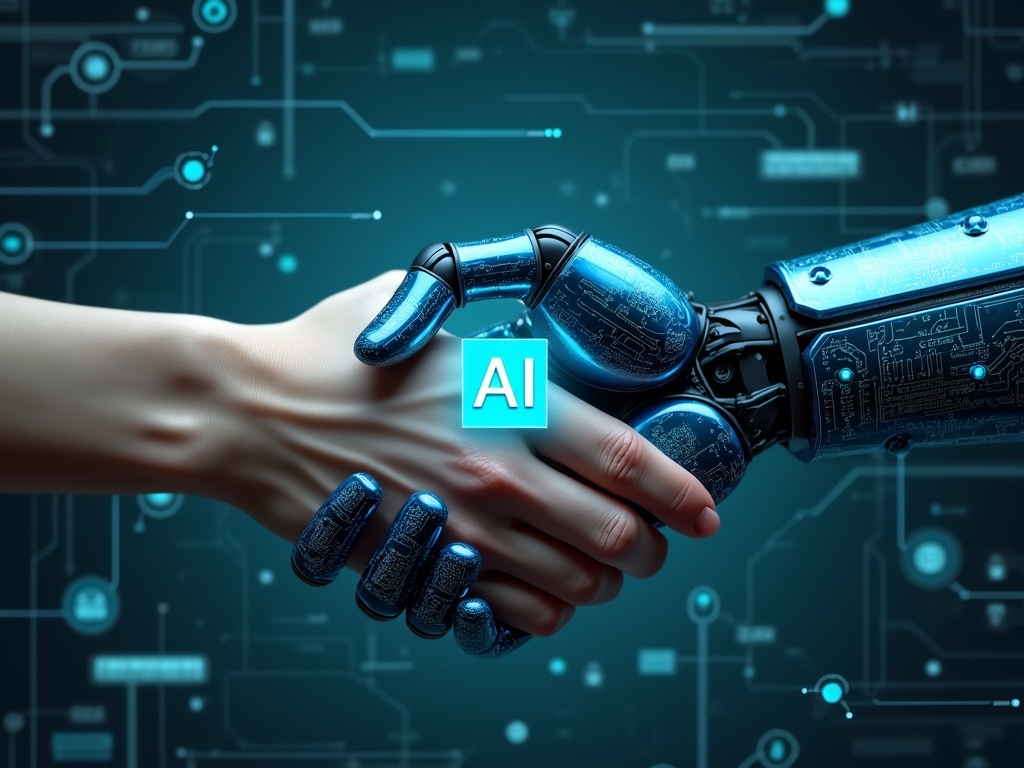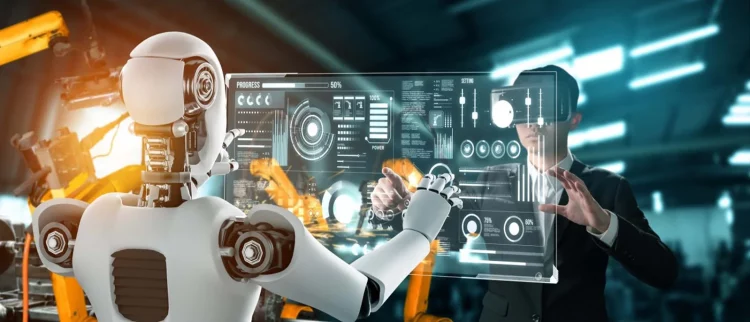Introduction
The integration of Artificial Intelligence (AI) into robotics has transformed the way machines interact with humans, opening up new possibilities for collaboration in industries ranging from manufacturing and healthcare to logistics and service. One of the most promising applications of AI in robotics is the ability for robots to understand human intentions and communicate effectively with humans. This ability is poised to dramatically enhance both work efficiency and safety, providing smarter, more responsive, and intuitive robotic systems that can seamlessly collaborate with human operators.
As industries move toward automation, there is a growing need for robots that can operate in dynamic and unpredictable environments, where direct programming is insufficient. This is where AI-enabled human-robot collaboration (HRC) comes into play. Through sophisticated algorithms, sensory inputs, and machine learning techniques, robots can interpret human behavior, predict intentions, and autonomously adjust their actions in real time, all while ensuring the safety and well-being of human workers.
This article explores how AI technologies enable robots to understand human intentions, collaborate seamlessly with humans, and ultimately improve productivity, efficiency, and safety in various work settings.
1. AI and the Evolution of Human-Robot Collaboration (HRC)
a. What is Human-Robot Collaboration (HRC)?
Human-Robot Collaboration (HRC) refers to the interaction between humans and robots in a shared workspace where both parties contribute to achieving common goals. Unlike traditional automation, where robots operate in isolation from humans, HRC involves a dynamic and interactive partnership between humans and machines. Robots, in this context, are not just tools but partners that can adapt, learn, and respond to human actions and intentions.
The key to successful HRC lies in a robot’s ability to understand human intent—whether that involves recognizing gestures, following spoken commands, or interpreting physical movements in a way that aligns with human expectations. With AI, robots can achieve this understanding and adapt their behavior accordingly, creating a seamless interaction that enhances workflow.
b. The Role of AI in HRC
AI plays a fundamental role in making HRC efficient and effective. Several AI technologies come into play:
- Computer Vision: Enables robots to perceive and interpret the physical world, recognizing human gestures, postures, and objects in the environment.
- Natural Language Processing (NLP): Allows robots to understand and respond to human speech in real time.
- Reinforcement Learning (RL): Empowers robots to learn from interactions with humans and improve performance over time through trial and error.
- Predictive Analytics: Uses historical data to predict human behavior and anticipate needs, allowing robots to adjust their actions accordingly.
The application of these AI technologies enables robots to act not only on direct commands but also on contextual cues and non-verbal communication, making the interaction more intuitive and human-like.
2. How AI Enables Robots to Understand Human Intentions
a. Understanding Human Gestures and Movements
One of the primary ways AI enhances human-robot collaboration is through gesture recognition and motion analysis. Humans naturally communicate through body language, gestures, and facial expressions, all of which are essential components of effective interaction. However, robots traditionally struggle to understand such cues, limiting their ability to work alongside humans effectively.
AI technologies, particularly computer vision and machine learning, enable robots to recognize and interpret a wide range of human gestures. For example:
- Hand gestures: Robots can be trained to recognize specific hand movements, such as pointing, waving, or signaling, to guide them in performing tasks.
- Posture and movement: Robots equipped with advanced sensors and AI algorithms can detect subtle changes in human posture or movement, predicting actions such as reaching for an object or stepping back, allowing them to respond appropriately.
- Facial expressions: AI can analyze human facial expressions to detect emotions such as frustration, confusion, or happiness, enabling the robot to adapt its behavior accordingly.
By recognizing and responding to these non-verbal cues, robots can make the collaboration feel more intuitive and natural, significantly enhancing the efficiency and smoothness of the interaction.
b. Voice Recognition and Natural Language Processing (NLP)
In addition to physical gestures, speech is a critical mode of communication between humans and robots. AI-driven Natural Language Processing (NLP) allows robots to understand spoken commands, questions, and requests. This is especially useful in scenarios where verbal communication is faster and more convenient than physical gestures.
With NLP, robots can perform tasks based on spoken instructions such as:
- Executing commands like “move this object” or “start the assembly process.”
- Understanding questions such as “Can you help me with this task?” or “What is the status of the project?”
- Responding in a conversational manner, providing updates or offering assistance based on the context of the discussion.
By continuously improving speech recognition models, robots can understand contextual meanings, sentiment, and even ambiguity in human language, making interactions more fluid and meaningful.
c. Predictive AI and Proactive Collaboration
AI-driven robots don’t just respond reactively to human commands—they can anticipate needs and predict human actions based on historical data and environmental context. This predictive capability is particularly useful in collaborative environments where proactive behavior can improve both safety and productivity.
For example:
- Warehouse robots can anticipate when a human worker is about to pick up a package and move aside to give space, improving workflow without explicit instruction.
- Manufacturing robots can recognize when a human operator is nearing a dangerous zone and can slow down or stop automatically to prevent accidents.
- Healthcare robots can detect signs of stress or fatigue in human workers and adjust their tasks to alleviate pressure or assist with heavier workloads.
This proactive capability is driven by machine learning algorithms that allow robots to learn from their environment and human behavior over time, ensuring a more seamless and intuitive collaboration.
3. Improving Work Efficiency Through Seamless Human-Robot Interaction
a. Task Automation with Human Input
In many industrial and service settings, robots are designed to handle specific tasks that are repetitive, dangerous, or physically demanding. However, the full potential of these robots is realized when they can collaborate seamlessly with human operators to optimize performance.
AI enables robots to assist humans in ways that improve both the quality of work and productivity. For example:
- Collaborative robots (cobots) in manufacturing can assist human workers in assembling products, lifting heavy objects, or performing intricate tasks that require precision. The robot adjusts its actions based on human progress, offering support only when needed, ensuring no disruption to the workflow.
- In healthcare settings, AI robots can assist doctors or nurses by handing over surgical tools, holding instruments steady, or managing medical equipment, while continuously adapting to the needs of the medical team.
By being able to understand human intent and adjust their actions accordingly, robots contribute to a smoother workflow, reducing downtime and improving the overall efficiency of operations.
b. Enhancing Human Productivity and Reducing Cognitive Load
AI-powered robots can also help reduce the cognitive load on human workers, allowing them to focus on higher-level tasks that require creative thinking, decision-making, or problem-solving. This is especially valuable in environments that require high levels of concentration, such as healthcare, education, or emergency response.
For instance, in a medical emergency, a robot can assist a healthcare worker by reminding them of critical actions (e.g., dosages of medication), assisting with minor tasks (e.g., fetching supplies), or providing real-time data for better decision-making. This allows human workers to focus on the most urgent aspects of care without being distracted by repetitive or routine tasks.

4. Improving Safety in Human-Robot Collaboration
a. Avoiding Collisions and Hazards
One of the primary safety concerns when humans and robots share workspaces is the risk of accidental collisions or injuries. AI helps mitigate these risks by allowing robots to sense and react to human movements in real-time, avoiding potential hazards.
Sensors such as LiDAR, ultrasonic, and RGB-D cameras allow robots to map the environment, detect human presence, and identify obstacles in their path. When a human comes too close or exhibits potentially dangerous behavior (e.g., walking into a robot’s path), the robot can adjust its speed, halt, or reroute to avoid injury.
b. Learning from Human Behavior to Improve Safety
As robots observe and interact with humans over time, they can use reinforcement learning (RL) algorithms to improve their safety protocols. By learning from previous experiences, robots can anticipate unsafe behaviors (e.g., workers getting too close to machinery or approaching dangerous zones) and proactively adjust their actions to avoid accidents.
For example, in a factory setting, a robot can learn which areas of the production line are most prone to accidents and ensure that its movements are restricted in those areas. Similarly, in an emergency response scenario, robots can identify high-risk zones and avoid them to ensure that rescue operations proceed smoothly.
5. The Future of AI-Driven Human-Robot Collaboration
The future of AI-driven human-robot collaboration holds incredible promise. As AI algorithms become more sophisticated, robots will be able to not only predict human intentions more accurately but also become even more adaptive to changing environments. The lines between human and robot roles will continue to blur, creating a highly integrated workforce where humans and robots complement each other’s strengths.
Furthermore, advancements in AI ethics and privacy considerations will be essential to ensure that the collaborative use of robots aligns with societal values and legal frameworks.
Conclusion
AI technologies are enabling robots to understand human intentions and collaborate with humans in ways that were once thought impossible. By leveraging AI-powered systems such as computer vision, natural language processing, and predictive analytics, robots are becoming smarter, safer, and more intuitive partners in a wide range of industries.
As AI continues to evolve, the seamless interaction between humans and robots will enhance work efficiency, productivity, and safety. This will not only revolutionize the workplace but also pave the way for a future where humans and robots coexist harmoniously, complementing each other’s strengths and ensuring optimal outcomes.
The key to success lies in creating robots that not only execute tasks but also truly understand the human context, anticipate needs, and adapt to the ever-changing dynamics of the workplace. By doing so, robots will become indispensable collaborators in the workforce, driving forward innovation and progress in ways that were once only imagined.











































